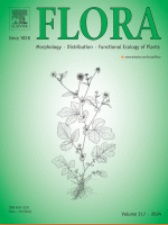Is staggered flowering phenology favoured by phenotypic selection? The case of two co-occurring Cnidoscolus species
Miguel A. Munguía-Rosas

Flora, Volume 317, 2024,152556, ISSN 0367-2530,
https://doi.org/10.1016/j.flora.2024.152556
Abstract
Staggered flowering phenology in sympatric plant species that share pollinators is often considered the ultimate strategy for avoiding pollinator competition or a facilitative strategy to maintain pollinators throughout the year. Some factors of the abiotic environment may also contribute to the maintenance of staggered flowering. Flowering (a)synchrony among conspecifics is recognized as a trait with selective value. However, little research has addressed phenotypic selection for (a)synchrony with other plant species. Here, I experimentaly examined the flowering phenology of two sympatric congeneric species (Cnidoscolus aconitifolius & C. souzae) that share pollinators and measured phenotypic selection on this trait. Preliminary field observation suggests that these species exhibit staggered flowering, so my main goal was to assess phenotypic selection on flowering (a)synchrony between the two study species (interspecific synchrony). I predicted that the plants that present greater interspecific synchrony would be selected against and would thus contribute to the maintenance of staggered flowering. However, the patterns of phenotypic selection found were counterintuitive: individuals of C. souzae with greater intraspecific synchrony were selected against, while those with greater interspecific synchrony with C. aconitifolius were favoured by phenotypic selection. I also found the opposite pattern of flower production response to temperature in this system, implying that the abiotic environment could partly explain the occurrence of staggered flowering. Since the phenotypic selection found in this study may select against the observed staggered flowering, reciprocal phenotypic selection between co-occurring plants cannot be invoked as a mechanism underlying staggered flowering phenology in these two Cnidoscolus species.